Lilo and Stitch: The Seven Standards of Disney
Disney is always prepared to shake things up. They don’t always go by the seven standards I identified within Disney movies, at least not in the conventional sense. Make no mistake, Lilo and Stitch does indeed follow the traditional standards, just in its own way. This, perhaps, is what makes it a great movie. When Disney movies repeat different themes in different ways, it runs the danger of being repetitive. The audience doesn’t need the same ‘true love’s kiss’ story a million times. Thankfully, it never backfired on them before. Sometimes, Disney sacrifices one standard for the enhancement of another. In Frozen, that works, but sometimes it doesn’t. (Note: It never failed to work, actually.)
The seven standards change and develop over time but the basic components remained the same, from the 30s till now. So far, countless Disney movies were given the treatment from me of being defined by those standards: Peter Pan was judged, Frozen, Tangled, and even the reigning Lion King were judged, even the lesser known The Black Cauldron was placed before the defining and pivotal seven standards of Disney. Some of these movies, like The Black Cauldron, failed to meet those standards. Other movies purposely ignored some standards, such as Frozen. Others still followed them to the letter, like Tangled. Whatever the movie, the seven standards were at the very least attempted.
In 2002, Lilo and Stitch hit cinemas. Originally, Stitch’s creator Chris Sanders pitched the idea of him for a children’s book in 1985, a pitch that was unsuccessful… at least until Disney approached him. Unfortunately, Stitch shook things up. The… other characters from the Disney family didn’t take kindly to him. He ruined the dance between Belle and the Beast, he messed up Ariel’s solo, he stole Aladdin’s love away, and he snuck himself into Rafiki’s arms and was held up over the Pride lands. He was never quite forgiven. At least, not in the trailers. He finally got his own movie, cast as something very different, and not in your traditional Disney movie we’re all used to watching.
The first film to grace us during the 2000s was Lilo and Stitch. One of the reasons traditional Disney fans despise this and other movies of its type like Meet the Robinsons and Bolt, not to mention the comedic Emperor’s New Groove, is because they abandoned their past principles they once relished and enjoyed. Disney started something new. However, even those movies stick with a certain formula, just in their own special way. This nontraditional Disney movie shall now be judged according to the Seven Standards of Disney Classics: The Origin/storyline, Disney Princess/protagonist, Disney Relationship, Disney Villain, Disney Music, Disney Setting, and Disney Characters.
Origin/Storyline
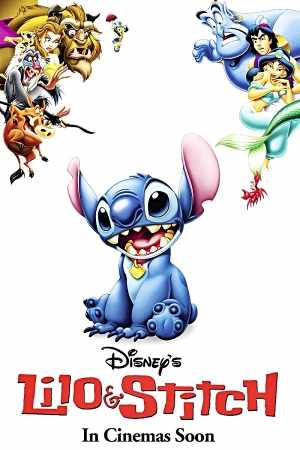
There’s not much to say in this standard because this movie is one of the very rare times Disney doesn’t adapt it from anything. You read right, it’s a completely original idea by Chris Sanders. No fairy tale, no book, no past bedtime story, nothing. In terms of actual standard, this actually makes this movie better than other Disney movies, at least in terms of origin. Because their origin was from paper, there’s not much to say. Stitch was originally created in the 1980s, but was never realized until the 2000s. When Stitch first started hitting the bit screen, he… ran into some problems. As said, he didn’t get along well with other Disney characters, apparent in his trailers as well as the cover of his movie.
A prologue of the movie starts with the Galactic Federation putting an evil scientist on trial. The scientist in question, named Jumbaa, is being tried for creating another life form with vicious tendencies. When the life form is brought before the Grand Council Woman, it breaks free and steals a ship pod. Of course, they engage it but it proves too resilient. As it takes fire from the Federation ship, it is set on a collision course for Earth. Since the experimental life form cannot survive in water, and most of the planet is covered with water, they show no worry… at least until they track it landing, coincidentally, on an island in the state of Hawaii. It is that Hawaiian island where this tale begins.
The movie starts with a Hawaiian musical number showing the beach and a little girl. The music ties in with the beginning as the girl rushes to the dancing number, late. Portraying her as a lonely little girl, Lilo’s sister takes her to the animal shelter to buy a dog. The dog she gets though is not a dog at all, but an alien, the same one that crash landed. They nonetheless mistake it for a dog and take it home to christen it Stitch. Lilo tries to handle this wild Stitch and meanwhile, two aliens from the Galactic Federation are hot on its tail. What happens next is where the plot begins.
A social worker is scheduled to come to the house to make sure Lilo is properly cared for. The worker, name Cobra Bubbles, is not pleased with how the meeting goes and gives Lilo his number in case anything ever goes wrong. He gives her sister, Nani, a few days to get things under control, get a job, and make that wild ‘dog’ into an upstanding citizen. If not, he has to take Lilo away to a family that will look after her. The next few scenes show their attempts to do just that. Lilo introduces Stitch to the island, teaches him to play music, relates to the Ugly Duckling, and the audience is given a back story of Lilo and how her family used to be whole before her mother and father died in a crash.
However, Stitch is just unable to be tamed. He came close, but camera flashes bothered him and destroyed the beach. As a result, Bubbles informed Nani that he would come by to take her away. The very next day, Nani’s friend David, who is established to be in love with her, comes by and tells her he found her a job. Things finally looking up, she leaves Lilo at home. It may have gone fine if the aliens on Stitch’s tail did not choose that moment to attack and take him away. The house is destroyed in the ensuing struggle and Lilo calls Bubbles for help. Nani rushes home and finds it destroyed and Bubbles with Lilo. He places her in the car and yells at Nani for carelessness.
The aliens having taken Stitch, Lilo runs off after them with Nani and Bubbles on her tail. The fight is taken to the air, Stitch ends up helping her, and they ultimately land on a beach. Then, the Galactic Federation shows up and captures Stitch at last with the Grand Council Woman presiding. Bubbles confronts her and Lilo reveals she paid for Stitch. Bubbles reveals himself as a CIA agent and negotiates their way out of it. The Council Woman places Stitch and the family under the protection of the Galactic Federation and leaves them in peace. Nani having a job, Stitch tamed, and the house being rebuilt, Bubbles allows them to stay together and they all live happily.
The movie makes clear that Stitch is different to other Disney movies. He simply didn’t fit in and neither did Lilo. It is Disney’s acknowledgment that Stitch does not fit in that saved him with this standard. The movie is meant to be wholly original and originality is a good thing. Disney’s ability to make original works and not movies inspired off previously written works means it is definitely capable of making any sort of movie. It is their openness about him that gave him a place, even if most other Disney characters despise him.
Disney princess/protagonist
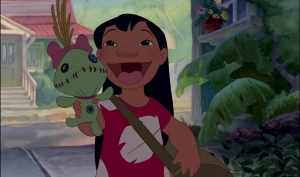
The protagonist is this movie is one of Disney’s few heroines who did not automatically make the Disney Princess list. Of course, since Lilo has no ties to royalty whatsoever, this can be accepted. Lilo is a lonely Hawaiian girl with no parents, no friends, and a single wild alien mutt who gets her into constant trouble. Lilo starts out swimming on the beach before realizing she is late for her dance rehearsal and rushes to the theater where her wet clothes drip and cause the other dancers to trip and fall. Later, she adopts Stitch, an alien created solely for destruction, and attempts to tame him. They quickly become friends when the aliens from the Galactic Federations attempt to track and neutralize him.
However, to pass this standard, the princess or protagonist in this case, needs to be unique in her own way. Something needs to set her apart from all the other Disney protagonists. Peter Pan was the spirit of youth, Simba was a runaway lion cup, and Elsa is the ice princess, but who is Lilo? Lilo is an orphan girl who lives in Hawaii with her older sister who looks after her. Like other princesses, she follows the trope of having an animal sidekick. Esmeralda had Jolly, Rapunzel had Pascal, Cinderella had mice and Snow White and Aurora had an army of animals. Their sidekicks are part of what give them character, because it says a lot about them. Stitch is an outcast, rejected by his own kind and so, in a way, is Lilo. The two outcasts come together and ultimately make friends.
Lilo is also relatable, because many kids in her shoes can feel lonely, even if they still have parents. This gives Lilo more relatable charm than usual Disney princesses, who typically end up in rich positions of wealth and power, very far removed from the audience, regardless of their beginnings. In fact, Disney’s recent film Frozen, began rich and powerful and ended rich and powerful. At the very least, Lilo lives in a state of the US, which actually exists in our real world, and she faces difficult problems that exist in our real world, that many kids have to come to grips with. In Lilo’s case, she is truly about to lose everything.
Disney romance/relationship
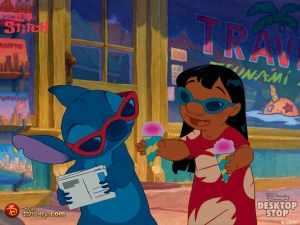
Lilo and Stitch does not have a main romantic relationship. Like The Lion King, it’s more about the relationship between friends, and like Frozen, a relationship between sisters. Lilo is looked after by Nani, her sister. Nani faces the prospect of losing Lilo if she does not prove herself capable of looking after her. After all, if Nani cannot provide, why should Lilo suffer? This is not helped when their relationship gets rocky. Lilo frequently acts out and refuses to listen or pay attention, but because the audience is given some access t her mindset, we can understand her pain. Their relationship is also given a very special, emotional scene when it is indeed decided that Lilo will be taken away.
Lilo is also given a relationship. This one is the main pillar of the movie. In fact, should this relationship fail the test, it could be argued that Disney failed in its intent. Thankfully, Lilo and Stitch are now one of Disney’s most famous dynamic duos. Lilo may have adopted Stitch as a pet, but he is quickly treated more as an equal. She attempts to tame him, to slay his wild, destructive nature. Stitch is taught to build rather than destroy, to create rather than demolish. This relationship faces enemies too, those who’d rather they do not interact. These forces are mainly the aliens who need to capture Stitch, and Myrtle who plays the role of Lilo’s bull. Even Nani sometimes suggests getting rid of him.
Another worthy relationship is the background romance between Nani and David, a friend of hers. This is more of a side show, and the end to it is really only implied. It is clear that David loves her, but she tells him she cannot do anything until she’s taken care of her own problems. He still exists to lend a helng hand to her and Lilo when he can. Near the climax, he rushes to inform Nani he found her a job. When she asked how she could repay him, he simply said ‘date me and we’ll call it even.’ In the very end, the real relationship is the dynamic duo of Lilo and Stitch.
Lilo and Stitch work because of their similarities. Both are destructive to those around them an even themselves in some cases, and unaware of the problems it causes for others. In the end, Lilo is a problem child. Like Stitch, she can get aggressive when someone touches a nerve in her, she can get feisty, and disobedient which can lead to a lot of problems at home and abroad. This is what makes their relationship click, is their similarities. They found themselves in each other and that ultimately tamed both of them. Their similarities help them click. A human and an alien becoming best friends, despite their official status as owner and pet, and learning from each other in a very fundamental way changes everything.
Throughout the movie, the relationships are really summed up in few simple words that leave a lasting impression upon many. Ohana means family, and family means nobody gets left behind or forgotten.
Disney villain
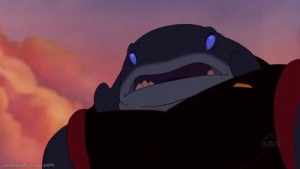
The Disney villain in Lilo and Stitch is Captain Gantu of the Galactic Federation. Captain Gantu is sent somewhere in the middle of the movie to capture the experimental life form because the initial two aliens sent were taking too long. Gantu is a big, large humanoid alien with very dark skin and very determined. It is at the end, when he succeeds in capturing Stitch, otherwise known as Experiment 626, when he truly becomes a villain Lilo must rescue Stitch from, even though he has a space ship and she does not. However, by the end, he fails and the credit of the capture goes to the Grand Council Woman herself. It seems she is being set up to be the main villain, since she is the one who sent the aliens in the first place. However, upon Cobra Bubbles revealing himself as a CIA Agent, she relents and places Stitch under her protection and leaves the island in peace with Captain Gantu fired.
Every Disney villain is somewhat required to have a sort of uniqueness to him or her, a sort of charm. Gantu is unique in the fact that he is an alien but beyond that, not much. To be honest, this may be the only standard Disney fails with. The reason for this is that Lilo and Stitch seems to be going for style over substance, and where this can work with all the other standards, with a villain like Gantu, it doesn’t. He doesn’t quite fit the wider setting which has brighter, livelier colors, and his failure upon entering the fray is quick. The only redemption was probably his boss, the Grand Councilwoman. Even she left them all in peace and fired him, so it turned out she wasn’t so bad after all.
For this reason, the Grand Councilwoman is only a means to an end, and fits more within the realm of memorable side characters rather than a villainess. The villains, Jumbaa, Pleakley, and Gantu are very sleazy and almost meaningless. The one-eyed Pleakley is comedic, Jumbaa doesn’t even want to be there, both actually become good in the end as outcasts too, and Gantu is disposed of so quickly, the plot becomes less about defeating the bad guy and more about taming Stitch and the Grand Councilwoman doesn’t even count anymore. In short, all those characters were only a means to an end, and in a studio where Disney villains are never only that, Lilo and Stitch did fail with this standard.
Is this a bad thing? Perhaps. It does explain why many dislike Lilo and Stitch, Meet the Robinsons and Emperor’s New Groove. These movies don’t make it a point to dish out particularly good villains, or even villains that are likable. Gantu is nothing on Jafar, Maleficent, or even the Horned King. Even The Black Cauldron, a Disney failure if there ever was one by conventional standards, did a villain better than this movie. With Gantu, Yzma, and the Bowler-hat Guy, villains in the movies of the early 2000s are meant to be more comedic than dedicated to substance. Then, if he’s meant to be comedic, then why didn’t he make anyone laugh? Perhaps Disney could’ve gone with their original plan but still at least made memorable villains. It can be argued that even Yzma is at least memorable in her own way so why isn’t Gantu? Because Disney failed.
Disney music
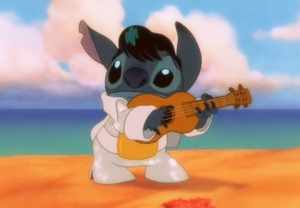
The music in Lilo and Stitch has clear inspiration. The most notable of them is ‘He Mele no Lilo’ which is played at the beginning. While Stitch’s trial is shown as a brief prologue to the film, ‘He Mele no Lilo’ starts the film out, and basically lets the audience know they’re in for a good movie. Like The Lion King did at their beginning, the song is purely foreign to English. It is pure Hawaiian. As the song- somewhat of a chant- goes on, it shows a little girl swimming in the beach, taking pictures of overweight tourists, and then rushing to her dance class. The song is then integrated as part of the film, with Hawaiian women and girls doing a traditional dance to the song itself. This is ultimately what gives the first song at least, some strength.
The rest of the movie did not lend itself much to music of the type Disney usually does. Compared to other movies, the movie may have well failed this standard like The Black Cauldron did but the fact Lilo and Stitch incorporated its own setting into the movie with music, the way Pocahontas did, and the way The Lion King did is a major plus for a movie which tried to set itself apart from other Disney movies. However, the rest of the songs in The Lion King are English, same with Pocahontas, but Lilo and Stitch continue with their Hawaiian theme in a song titled ‘Hawaiian Roller Coaster Ride’, which is sung in the background as the characters attempt to incorporate themselves into the rest of the community.
So, doesn’t this have a minus when the movie uses music that is purely Hawaiian, therefore something most people in the world will not be able to understand? Yes and no. It’s always a risk, but it’s a risk Disney has proved itself as able to take. The beginning is pure Hawaiian, but Hawaiian Roller Coaster Ride actually has English incorporated into it, reflecting Stitch and Lilo trying to incorporate themselves into the community like Bubbles ordered them too. As they try this, Lilo teaches Stitch some conventional American music, thus tying Disney to Elvis Presley, and allowing the movie to further connect itself with the audience. It is for this reason that Lilo and Stitch passed the musical standard, something subsequent Disney movies failed to do.
Disney setting
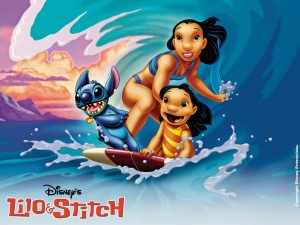
The setting of this family tale is simple: Hawaii. Specifically a single island in Hawaii, we don’t see any other islands. Hawaii of course, has a reputation for being a beautiful state in the US with white sand, beaches, the wide sea, and natural volcanic activity viewable from a safe distance. All in all, a great place to be aesthetically. That is exactly what Lilo and Stitch was going for here: Aesthetics. It’s meant to be beautiful. Just looking at the drawn animation of the scenery pulls the audience in, at the very least makes them interested exactly what they’re in for when they watch. Taking place in the latest state to join the union of the US, it gives its own culture closest to home.
Of course, beautiful setting isn’t going to be enough. In a movie like this, it needs culture with the setting. The Lion King started with a Swahili song in the background building up to the ‘Circle of Life,’ and even the Native Americans had their number to go with their own culture. ‘Arabian Nights’ began in Aladdin, and while Hercules didn’t have a Greek song, the imagery of the muses singing the song were Greek paintings. Lilo and Stitch is the same as these movies. It begins with a Hawaiian dancing number, and begins with women and girls dancing a traditional Hawaiian dance to a song named ‘He Mele no Lilo.’ Beginning with the blue ocean and transitioning to the dance introduces the audience to the culture of Hawaii, straight off the bat.
The music is mostly Hawaiian too, from ‘Hawaiian Roller Coaster Ride’ to ‘He Mele no Lilo.’ Disney plays it safe with fantasy kingdoms, but when they go under the sea, or to deserts beyond their borders, and then return to their borders only to give a different culture within, they do what they do best. In this case, this standard connects very nicely with the musical standard of the film, and when standards connect, the film has a sense of coherency and a very natural feel to it. This natural feel is enhanced by the wider plot between Lilo and Nani, let alone Stitch, thus connecting this standard further to the storyline standard and the character standard- all of whom are Hawaiian- thus giving it a bigger plus. In short: Lilo and Stitch won this standard hands down, no question about it.
Disney characters
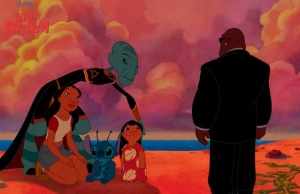
Characters give a movie color and director, it gives a movie and its main character dimension and, in most cases, motive. The characters in Lilo and Stitch are like the characters from Beauty and the Beast, The Little Mermaid, Aladdin, and even Snow White. Truth is, Disney is good at such characters, side-characters that add such color to a movie. Snow White had seven of these characters, each one unique and named for their own traits in their own way. Beauty and the Beast had Lumiere and Cogsworth, and that’s not counting Mrs. Potts or Chip. Who can forget the comedic Genie from Aladdin, or Sebastian the crab? No one, because they’re all memorable. These characters left their mark.
So, in Lilo and Stitch, we have plenty: Jumbaa, Pleakley, the Grand Councilwoman, Cobra Bubbles, Nani, and David. Since the Grand Councilwoman was clearly not meant to be a villain, we have her as a character. Jumbaa and Pleakley are definitely characters in their own right, throughout the movie trying to catch Stitch with comedic effect. The memorable characters here are Jumbaa, Pleakley, Nani, David and Bubbles. They all leave their own marks, and it’s up to the audience to decide which one does it to greater effect, since they all have their motives. Jumbaa and Pleakley are just there on orders, the Councilwoman has a job to do and Gantu was sent to catch Stitch, succeeded, and then retired for failure. David has a long-standing crush for Nani, but the real character in this movie to be remembered is Stitch, and Stitch overshadows them.
Perhaps being overshadowed by someone who takes the place of the second party in the movie relationship is a letdown. It would explain why some simpy don’t like this movie. Jumbaa and Pleakley are fools, clowns really. Nonetheless, they have a base of fans. The ones who really left a memorable mark were Nani and the Councilwoman, let alone Bubbles. Bubbles, however, serves as part of a problem. In the end, the movie is realistic and everyone acts for their own interests, sometimes coinciding with the main interest. In the end, all interests come together in the forms of all these characters. If the movie meant to portray real life in a magical way, it succeeded, and it succeeded through those characters. Add in Bubbles speaking of the conspiratorial Roswell alien landings like he’s been there, and saving the planet from aliens, and it adds a bit of historical context too. Lilo and Stitch succeeded, maybe not as well as other moves before it, but it succeeded nonetheless. And who’s comparing anyway?
After the Disney renaissance of the 90s, Disney stopped going for ‘Princess’ movies and started going for something different. This was probably an attempt at expanding their base. It certainly wasn’t lack of budget after the windfall they enjoyed for the past decade. Instead of going for magic, it went for realism and… aliens. Yeah, it’s something that can sound pretty weird for a movie of its type, but it works. The characters make it work and they make it work well. So, Lilo and Stitch was disliked by other Disney characters, it does well on its own, and being an outcast is exactly what the movie was about. In this case, and rarely is this done, the trailers seriously set up their own movie.
Lilo and Stitch may be outcast from the usual band of Disney movies, but it does have its place. It’s not the perfect movie, and compared to others, it may have fallen short. Like The Black Cauldron, it does well as a movie on its own; however, unlike The Black Cauldron, it also does well as a Disney movie. So Gantu falls before the Horned King, Lilo, Stitch, Nani, Bubbles, the Grand Councilwoman, and the two aliens Jumbaa and Pleakley all make up a fantastic story full of enjoyment, beauty, and of course, endearing relationships enough to carry it through the ages as a Disney classic… and surely one of Disney’s best. So, the next time anyone watches this movie with grudging acceptance, just remember the spirit of Ohana, and the endearing characters and watch it with a relation to the real world we all live in.
What do you think? Leave a comment.
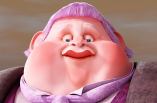

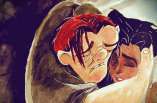







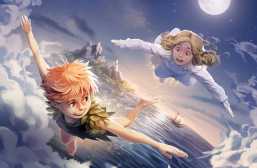
Lilo and Stitch is one of my favorite Disney films because of all the positive and complicated character interactions (Nani and Lilo; Nani and David). This turned out excellent, and I’m glad to see that Lilo and Stitch holds up!
It’s one of my favorites too. A lot of people dislike the movie, particularly when compared to movies that came before it, but really it’s a good movie.
Something of an oddball for a Disney film!
True, but still good.
This is a great film no matter how you look at it. What really makes this such a wonderful movie is its warmth and maturity.
Not to mention its stylistic visuals.
It’s a Disney film. You love or hate or sometimes just go eh. But Lilo and Stitch for me as a kid made me want a pet and Stitch himself.
For me, it made me wish I was Cobra Bubbles. However weird that sounds. In fact, I have to give a shout out to the Grand Councilwoman.
Lilo and Stitch is easily one of my favourite Disney films 🙂
The part about spaceships and aliens was the least interesting in the movie.
I sort of agree. I like the following prologue better, captures the setting much better.
My daughter and I love this movie. We have watched it several times! It is one of the best family movies I have ever seen! It has EVERYTHING!
That’s why I like it. It does lack an intriguing villain though.
I really like Elvis Presley and I get a picture of surfing and Hawaii. What I really like about this movie is the theme of family. It’s true that we can’t leave them behind. No matter how much of a pain they are at times.
And Nani is a major pain for Lilo 😀
My favourite Disney films of all time just so happen to be 2 films that came out in 2002. Lilo & Stitch and Treasure Planet.
Oh, I loved Treasure Planet. Such a good movie. Good pick going off Treasure Island.
This movie is so ridiculously cute.
I would have liked to see our human characters become more alarmed after spotting Stitch and the other aliens, because it is not everyday you see space creatures roam around in your backyard.
Well, they didn’t really know they were aliens until later, in the heat of more intense parts. No time to show alarm.
It’s hard to believe this movie came out in 2002. I loved this movie when it first came out, and I still love it even now.
Usually I’m not against Disney making films that stray from their usual formulas (heck, I liked “The Black Cauldron”) but “Lilo and Stitch”, being one of those films, just didn’t work for me.
To me this is one of Disney’s best if not the best Disney movie ever made.
The film was kinda bland for me,I dunno why but it wasn’t as hilarious as let’s say Aladdin,it was sort of depressing in a way,but still I did enjoy this movie.
I personally despise Disney, finding it too positive, commercialized and full of stereotypes. Lilo and Stitch honestly surprised me. This was one of the few Disney films I really enjoyed.
I loved the Lilo and Nani relationship in the movie, but as a whole the movie was kind of ‘eh’ for me.
Great analysis though. I enjoy your “Seven Standards of Disney”.
Sweet, funny movie!
This one has the power to move anyone. So true and organic storytelling.
What a great article — Lilo and Stitch is an outlier but still (in my generation) beloved. Thanks for your great writing and analysis! I enjoyed the read.
It taught me that when you aren’t looking for something it will always be there.
I think you were so busy tying the movie to “the seven standards” that you missed the its point: Lilo and Stitch are BOTH monsters, striking out at a world they’re not made for – Lilo is angry at a world that took away her parents & stable life while Stitch is angry at a world that labels him as a monster & treats him accordingly. The key to the whole movie is Jumbaa’s musing about what it must be like to be a monster like Stitch, “without even memories”… and the same can be said about Lilo, who has few memories of her dead parents. Yes, Lilo starts out to rescue the captured Stitch – but, after Stitch escapes, it it Stitch who has to rescue the now-captured Lilo. And he does so by flying up to Gantu’s ship, powered by a deliberately-set explosion, in a Superman pose (just like The Iron Giant flying up to save the town from the nuclear missile) – he has decided not to be a monster anymore. When he asks the Grand Councilwoman for permission to say goodbye, she assents – fascinated – because monsters don’t ask permission for anything. It is this proof that Stitch is no longer a monster which convinces her to leave him in exile on Earth – which also conveniently leaves him, Jumbaaa, & Bleakly out of the Federation’s hair.
I’m really glad you posted this comment, Howard, because it brings up a lot of ideas I had while reading this article. I especially love the tie-in to The Iron Giant, and the idea that both Lilo and Stitch are monsters. The ending of the movie is so moving because of the very reasons you point out – instead of trying to escape or destroying his bonds, Stitch humbly accepts his fate if he can only say goodbye to the family he has made for himself on earth. This is so important because it shows the empathy and emotion Stitch has developed during his time on Earth with Lilo. The Grand Councilwoman is set up as the antagonist but ends up working as the deus ex machina or “fairy godmother” role in the narrative, granting Stitch’s wish to live on Earth with his new family in peace.
This has been my favorite disney movie from the time it has come out until now I have seen it about a thousand times and I have never looked at it that way. Im glad you brought that up, looking back at the movie there is many instances where people view Lilo as a monster, just like Stitch. I think the whole movie stands to show children that just because you are different from most does not mean there are not people like you out there.
This movie brought me to tears the other night. It was a classic for me as a kid (pretty sure I have a VHS copy of it stashed somewhere in the basement…), for its simple storyline and cute and relatable characters.
The scene in the forest where he cries out “I’m Lost”, in the hopes that his family will come find him, had me sobbing.
I’m a big fan of Disney. I enjoyed your breakdown of the seven standards. This is a concept that I hadn’t considered before. I wonder what standards you could apply to early Disney, prior to their generation of Princess films.
Lilo and Stitch is a favourite of mine – it was great to see someone else loves it as much as me! I loved your analysis of it, and of Disney movies in general.
Everything you’ve pointed out as a deviation to Disney’s seven classic traits is what makes this movie so appealing. I think even people who grew up with the classic Disney movies were tired of seeing the same damsel in distress that needed saving. I think this movie is sort of iconic in a way, it’s one of few Disney films that actually promote more than girls needing to find love with a man. This movie, much like Pocahontas and Mulan were about a lot more than simply building a relationship. It’s a fantastic film.
Wonderful examination of a wonderful movie. I think many people realize how different of a Disney movie Lilo and Stitch is on a more subconscious level where they don’t give it too much thought, but this analysis has genuinely made me acknowledge what I, and many others, knew about the movie and observed but couldn’t quite explain or distinguish what sets it apart from other Disney movies beyond the fact that it isn’t a princess story. Even that it’s an original story isn’t an often talked about or even realized fact and the mere incorporation of aliens is a subconscious observation that’s rarely fully realized and it’s popularity is often overlooked in my opinion.
Lilo and Stitch is such a great and diverse film.
Thank you so much for this article! I enjoyed it tremendously, and am happy to see someone tackle such a non-traditional film of Disney’s. I am also glad to see you compare it to what you call the ‘seven standards of Disney.’
I am actually curious about your treatment of the classic Disney villain. Notice how Jumba is originally case as the most villainous, the one who creates Experiment 626 in the first place. He strikes me as the most adorable villain, if he is a villain at all. Captain Gantu, on the other hand, is simply following orders and has more of a temper since he keeps on messing up his assignment. Can we really say that either of them are a villain? After all, the Grand Councilwoman says that the laws these aliens obey are ABSOLUTE. Could it be that there are no villains in this movie? Or, does “Lilo and Stitch” ask the viewer to consider that circumstances create ‘enemies,’ more that assuming that any one person (or alien) is inherently evil?!
Thanks again! 🙂 Really got me thinking 🙂
I would have loved a click-through source to the original breakdown/explanation Seven Standards. I wonder if there couldn’t have been a more liberal interpretation on the first point (princess/protagonist) and as I read through the comments I see that my input isn’t entirely original, as it’s been pointed out that Lilo can uniquely be categorized as a monster in her own right. Thanks for the read!
For those who noted the similarity with The Iron Giant, I thought the same as I was reading this article, as I just watched The Iron Giant last week. Lilo and Hogarth are both lonely children who find a meaningful relationship with another lonely being. I think they’re really appealing characters because they’re really normal children, easy to relate to, and younger than the average animated protagonist, who is usually in his or her late teens. I always really liked this film and enjoyed this article 🙂
It might be more of an oddball when it comes to disney films, but Lilo and Stitch really seems to work on a child’s level to teach morals. While many disney films work with princesses and adults/teens, Lilo is a child. Of course children love the beautiful princesses and dashing princes, but are they really going to take any of the lessons from the story? Maybe. But they might just focus on the glamours. Lilo and Stitch, however, might help communicate the need to be kind and gentle and to cherish the childish moments of youth better because the young characters can be easily identified with. Thanks for the post, I never really thought about how Lilo and Stitch differed from the usual Disney movies. But, now that I have thought about it, I don’t know if I will be able to see it differently.
Lilo and Stitch is my favorite Disney movie and this article confirms why. The movie breaks the mold of the typical Disney movies. It focuses on multiple relationships and none of the relationships are romantic ones. The first relationship is between Lilo and her sister Nani. Their relationships show how powerful the bond is between siblings. Even though they don’t always get along they love each other and will be always be there for each other. The second relationship is between Lilo and Stitch. Their relationship shows that it is ok to be a little different and not always fit in. This movie really shows that even when things are not going well there are people that love you and will care for you.
One of my favorites for sure, and also completely underrated. It’s good to see it get some attention!
I have always thought that Lilo and Stitch is one of the best modern Disney movies, and not just for the many ways it changed their formula. It’s really beautifully animated, the soundtrack works (though it is different from the average Disney film, and, as you said, there is some realism. For me, this sets a standard for the Disney movies of the early 2000s, most of which get overlooked.
Really appreciated that you chose this movie to discuss since it was one of my favorites to watch growing up. However, I found that it was a little difficult to follow. A lot of time was spent on explaining the plot and not as much time was spent explaining the Disney standards. Maybe a shorter synopsis of the film can make your goal here more clear.
I grew up on the Disney Renaissance movies (late ’80s-circa 1998). Anything after that tends to get a skeptical eye from me, but I definitely see where Lilo and Stitch has value because it is so different. I especially like the focus on Lilo and Nani as sisters (Frozen thinks they were the first to do this, but no–and if I weren’t such a traditional Disney musical fan, I might even argue Lilo and Stitch does it better).
It is weird that the only reason Earth continues to exist in the world of Lilo & Stitch is because mosquitos are considered to be and endangered species by aliens but it works as a comic bit.
Lilo and Stitch falls into the Hawaiian tradition of “fictional hero stories,” as opposed to mythological ones, that are sort of serious jokes or tall tales. A hero is a misfit boy or girl, always doing strange things and making trouble, often with spirits of the dead and animals as friends, and often related in some mysterious way to magical trees or other creatures as if partly their child or a gift from them. The way the family and community treats the hero, as a strange child, is a sort of judgment of the family’s worthiness, and might influence things like future crops.
The hero eventually goes out and does big things, often with the help of some strange heroic companion or animal. Sometimes the hero fights great monsters or villains, or meets up with the gods and makes peace. If the hero has not been treated well, the hero might get revenge on his family or community. The child’s strangeness is revealed to have been because the child has special powers and senses, and can communicate with all kinds of creatures.
Elvis as a dead spirit mentor, not to mention the surfer Duke, fit right into this.
Nobody ever mentions this stuff, but it sprang off the page when I read a book about Hawaiian mythology and folklore.
Oh, and being clumsy or having a mysterious inability to do normal things is also part of the Hawaiian fictional-hero archetype. It’s related to their spirit heritage (like being a tree basically), or to being too strong to handle their own powers and strengths.
When the hero becomes an adult, these are usually no longer problems.